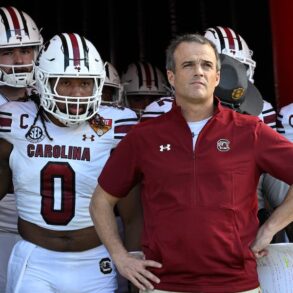There are elements inherent to Ohio State’s 2024 national championship run that separate it from the eight others in school history.
As the victors of the first 12-team playoff in college football, last year’s Buckeyes were the first team, period, to win four College Football Playoff games on their journey to hoist a national championship trophy. That gauntlet included undefeated No. 1 Oregon, No. 3 Texas, No. 5 Notre Dame and No. 7 Tennessee, based on the CFP committee’s final rankings (not the CFP seeding after conference championships shifted things around).
But when a storied program like the one that calls Columbus its home completes a championship tale, there are always echoes of the past. So, here at Eleven Warriors, we find it fitting to break down the parallels and differences between the 2024 team’s ultimate triumph and that of the Buckeye title-winning squads that have come before.
Given that a majority of Ohio State’s national championships were won before Woodstock, statistical evaluations aren’t going to be as apt for analyzing these seasons. You don’t need a 27-year-old whose football career peaked and concluded in high school to tell you the differences between the modern-day Ryan Day offense and Woody Hayes’ T-formation. These comparisons are driven by storylines; they are by no means a comprehensive list and are, in part, subjective.
For the sake of simplicity, we’re excluding the Buckeyes’ – let’s call them disputed – crowns in 1961 and 1970. They lost their final game in the latter year, after all. That leaves us with 2014, 2002, 1968, 1957, 1954 and 1942.
Four Parallels to Other Championship Runs
A Freshman Phenom – 2002
The similarities between Maurice Clarett’s 2002 freshman campaign and Jeremiah Smith’s in 2024 for Ohio State are striking.
Both were five-star prospects out of high school with jaw-dropping recruiting tapes. Both started right away and made an instant splash, Clarett rushing for 175 yards and three touchdowns against Texas Tech while Smith posted 92 receiving yards and two scores in their debut games.
Clarett had 1,341 yards from scrimmage and 18 total touchdowns. Smith had 1,352 yards from scrimmage and 16 total touchdowns, though it should be noted he played five more games than Clarett did in 2002.
The first true freshman ever to be a day-one starter at tailback in Columbus, Clarett set the freshman school records for rushing yards (1,237) and rushing touchdowns (16) in 2002. Smith set the freshman school records for receptions (76), receiving yards (1,315) and receiving touchdowns (15) in 2014.
And both made the play of the game in their respective national championship appearances. Clarett robbed Miami defensive back Sean Taylor of the football after he intercepted an endzone pass from quarterback Craig Krenzel:
Smith sealed Ohio State’s latest national championship with the since-dubbed “3rd-and-Jeremiah” play.
JEREMIAH SMITH DOWN THERE SOMEWHERE
pic.twitter.com/GVtQqoDKdz— Ohio State Football (@OhioStateFB) January 21, 2025
Dominance in Title-Clinching Games – 2014, 1968, 1954
Texas gave Ohio State all it could handle in the CFP semifinals and Notre Dame came back late to make the national title game scoreline a respectable 34-23, but the Buckeyes were less of a scrappy underdog and more of a steamroller through the playoffs.
Day’s dominators dove out to a 21-0 lead against Tennessee to win 42-17, a 34-0 advantage against top-seeded Oregon (we have a shirt!) to win 41-21 and a 31-7 edge over the aforementioned Fighting Irish. Ohio State punched its ticket to the CFP with a 38-15 clobbering of then-No. 10 Indiana.
Previous championship squads have won big on the biggest stages in Buckeye lore. The most memorable example has to be in 2014, when the Buckeyes leapfrogged Big 12 outfits TCU and Baylor to backdoor into the CFP as the fourth of four seeds thanks to a 59-0 shelling of Wisconsin. They played an instant classic against No. 1 Alabama in the CFP semifinals, winning 42-35, but No. 2 Oregon ultimately posed no threat. Ohio State turned the ball over a season-high four times and still produced an emphatic 42-20 win.
Both the 1968 and 1954 teams smoked their most critical opponents in claiming college football’s throne, even if they played in an era that predated championship games altogether. No. 1 Purdue rolled into Columbus on Oct. 12, 1968, and had any of its title ambitions shut out in a 13-0 loss. No. 4 Michigan resembled a MAC squad in a 50-14 defeat (Woody couldn’t go for three) and even Heisman Trophy winner O.J. Simpson with his No. 2 USC squad was no match in the Rose Bowl as the Trojans jumped out to a 10-0 lead only for the Buckeyes to score 27 unanswered points, take a 27-10 lead and win 27-16.
In 1954, Ohio State handed No. 17 USC a similar 20-7 fate in the Rose Bowl and demolished its toughest in-season competition, No. 2 Wisconsin, by a 31-14 scoreline. The always-pivotal Michigan game was won by multiple scores over a Wolverine squad ranked 12th, 21-7.
Driven by Defense – 2002, 1968, 1957, 1954
No surprises on this trend. Great defenses and great Ohio State football go together like chocolate wrapped around peanut butter in the shape of a certain poisonous nut.
The Buckeyes had a great offense in 2024, too, and indeed in each of their championship seasons, but the defense was the engine for at least five of their seven undisputed titles. The 2024 squad finished No. 1 in scoring and No. 1 in total defense (despite an extremely difficult schedule!). They made iconic goal-line stand after iconic goal-line stand, including game-saving goal-to-go efforts against Nebraska, Penn State and Texas.
Jim Tressel’s brand of football centered on defense and special teams, and his national champion never allowed more than 21 points to be scored in regulation. That 2002 team was No. 2 nationally in scoring defense and shut down Miami’s fearsome attack in the BCS national championship game, holding the undefeated defending champions to 17 points in regulation and making a goal-line stand to secure a 31-24 victory in double overtime.
The 1968 outfit held each of its three top-five opponents to 16 points or less, and no team scored more than 14 points against the 1954 squad. Only one Ohio State opponent cleared that 14-point benchmark in 1957, manufacturing the Buckeyes’ lone loss of the season in 18-14 fashion to TCU. But those pains were erased a few months later when their ballstoppers dismantled Oregon’s attack for a 10-7 Rose Bowl win and a national title.
Injuries That Seemed Season-Derailing – 2014
Most Ohio State fans probably can’t recall where they were when they first heard the news of Seth McLaughlin’s season-ending Achilles tendon rupture this year, but they can recall the feeling of anxiety it brought.
The Buckeyes’ offensive line had barely weathered its first storm, a season-ending knee injury to Josh Simmons against Oregon (the regular season edition) that required Donovan Jackson to bump out from left guard to left tackle so that the front wouldn’t look as anemic as it did against Nebraska the following game. Jackson had acclimated quickly, but now, without its Rimington Trophy-winning center, Ohio State’s offensive line didn’t look to be in title-winning shape after the Michigan loss.
But oh, how they rewrote all those narratives.
Jackson emerged as one of the best left tackles in the country, Josh Fryar gutted out an injury to put on a tremendous CFP run, Carson Hinzman stepped up at center and a newfound rotation of Luke Montgomery, Austin Siereveld and Tegra Tshabola at guard paved the way for Day’s first national championship.
The perfect parallel to the Buckeyes’ 2024 offensive line can be found in the 2014 quarterback room. Braxton Miller, set to return as the starter after a fantastic 2013 campaign, suffered a season-ending torn labrum in preseason camp and thrust redshirt freshman J.T. Barrett into the spotlight.
In Week 2, Barrett went 9-of-29 with three interceptions behind a front five resembling Swiss cheese and Ohio State was upset at home by unranked Virginia Tech 35-21. The Buckeyes looked like no national championship contender.
But Barrett played elite ball the rest of the 2014 regular season, averaging 238.9 yards per game and 8.8 yards per pass attempt with 31 touchdowns and six interceptions. He added 818 rushing yards and 10 scores on the ground in that span.
That’s 41 total touchdowns Barrett was responsible for in his final 10 games for the Buckeyes in 2014. And that year’s offensive line gelled, too.
Then, Barrett suffered a season-ending ankle injury in Week 14 against Michigan. Ohio State held on for a 42-28 win, but it was third-string redshirt sophomore Cardale Jones who would have to quarterback the Buckeyes in the Big Ten championship against No. 13 Wisconsin and pending Heisman Trophy runner-up running back Melvin Gordon.
Jones completed 61.3% of his passes for 742 yards (247.3 per game) and five touchdowns in his three starts to close the 2014 season, adding 90 rushing yards and a score on the ground. Known for his deep balls to wide receiver Devin Smith, “12 Gauge” averaged 9.9 yards per pass attempt and moved the chains with powerful running in key moments.
Like when he trucked over 310-pound Oregon defensive tackle Alex Balducci for a first down on 3rd-and-3 in the CFP national title game.
Whether losing two offensive linemen or two quarterbacks to season-ending injuries, the 2014 and 2024 championship teams overcame attrition that – at least at first – seemed crippling.
Two Traits Unique to 2024
Senior-Laden Squad
Jeremiah Smith is Jeremiah Smith and Caleb Downs is Caleb Downs, but the core of Ohio State’s 2024 title team was built around seniors. Seventeen of its starters were seniors. The most famous play of the title run was made by a senior, the senior who embodied the spirit of the team better than any other.
JACK SAWYER SCOOP-AND-SCORE
Ohio State is one step closer to advancing to the national championship! pic.twitter.com/BPoV5FBRGZ
— ESPN (@espn) January 11, 2025
One would expect senior-heavy teams to be common among Ohio State’s national championships. Experience usually translates to results. But shockingly, they are a historical exception in a lineage of Buckeye nattys won by relatively young teams.
The brightest stars of the 2014 team were underclassmen like Ezekiel Elliott, Joey Bosa, Michael Thomas, Darron Lee and Vonn Bell. Beyond Clarett in 2002, Krenzel quarterbacked as a junior, two-way star Chris Gamble was a sophomore, leading receiver and “Holy Buckeye” recipient Michael Jenkins was a junior, as was fearsome edge rusher Will Smith.
1968? That team’s nickname was literally the “Super Sophs.” 1954? Driven by a junior Howard “Hopalong” Cassady, who many reading this have heard of, and sophomore/future Pro Football Hall of Famer Jim Parker.
This trend dates back to Ohio State’s very first national championship under Paul Brown in 1942. Sophomore fullback Gene Fekete led the team in rushing with 910 yards at a clip of 4.9 per carry with 10 touchdowns. All-American halfback Paul Sarringhaus, the closest player the Buckeyes had to a quarterback in that era of football (he led the team in passing yards with 510), was a junior. All-American guard Lin Houston and All-American tackle Chuck Csuri, who Brown once called “the perfect tackle,” were also both juniors.
The brightest star of that team, senior halfback Les Horvath, is a notable exception. But Horvath also took advantage of a special rule during World War II to come back for one more season as a graduate student in 1944, the year he took home Ohio State’s first Heisman Trophy, so was he really a senior? In any case, the core of the 1942 team was built around sophomores and juniors.
All those teams had their contributions from seniors, of course. But the seniors were the fabric of Ohio State’s 2024 national champions in a way unprecedented by its previous title-winners. Well, excluding 1970 as previously stated, anyway.
Rivalry Heartache
I know there are fans out there tired of seeing the Michigan loss brought up when discussing the crown Ohio State captured in late January.
But in life, some of the sweetest joys come when produced by the greatest pains. The pit of despair and ugliness that was a fourth-straight rivalry loss for Day, his players and the Buckeye faithful was among the lowest moments in Ohio State history. The Wolverines were a five-loss team. The Game was in the Shoe. But a bad gameplan and equally bad offensive execution cost them a shot at more than revenge, but in the eyes of many in the fanbase, a shot at justice following the Connor Stalions scandal. The Scarlet and Gray fell 13-10.
Remember that pain. Now watch this joy.
There are nine total national championships claimed by Ohio State in its 145 years of football history, and last year’s is the only one to include a loss to Michigan. Rather than letting that wound fester and kill the whole season, the Buckeyes ensured that the loss galvanized them, spoke hard truths in a players-only meeting with Day and made the changes necessary to climb to college football’s mountaintop.
It’s not a fact to be ashamed of. It’s a fact to be celebrated. Even if it still hurts.
This post was originally published on this site be sure to check out more of their content.







